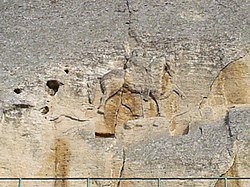Madara (village)
|
Madara Мадара |
|
|---|---|

The Madara Rider
|
|
| Location of Madara | |
| Coordinates: 43°17′N 27°6′E / 43.283°N 27.100°ECoordinates: 43°17′N 27°6′E / 43.283°N 27.100°E | |
| Country |
|
|
Provinces (Oblast) |
Shumen |
| Government | |
| • Mayor | Hristina Dimitrova |
| Elevation | 203 m (666 ft) |
| Population (2008)[1] | |
| • Total | 1,299 |
| Time zone | EET (UTC+2) |
| • Summer (DST) | EEST (UTC+3) |
| Postal Code | 9971 |
| Area code(s) | 05313 |
Madara (Bulgarian: Мадара, pronounced [ˈmadərə]) is a village in northeastern Bulgaria, part of Shumen municipality, Shumen Province. Madara lies 15 kilometres (9.3 mi) east of the city of Shumen, at the western foot of the Madara plateau.
Madara is famous for the Madara National Historical and Archaeological Reserve 1.5 km (0.93 mi) east of the village, one of the 100 Tourist Sites of Bulgaria. The reserve includes Neolithic and Eneolithic findings, a Thracian settlement, Ancient Roman villa and fortress from the 2nd–5th century, medieval Bulgarian palace, pagan sanctuaries, Christian churches and monasteries and fortresses from the First Bulgarian Empire. There is also a cave monastery from the 12th–14th century. Most importantly, Madara is the location of the famous Madara Rider, an early medieval (early 8th-century) large rock relief carved by the Bulgars and also featuring several epigraphs of historic importance written in Medieval Greek; the relief most likely dates to the reign of Tervel of Bulgaria.
The archaeological reserve was first studied by the Hungarian archaeologist Géza Fehér and then by the Czech-Bulgarian Karel Škorpil and the Bulgarian Rafail Popov.
...
Wikipedia

